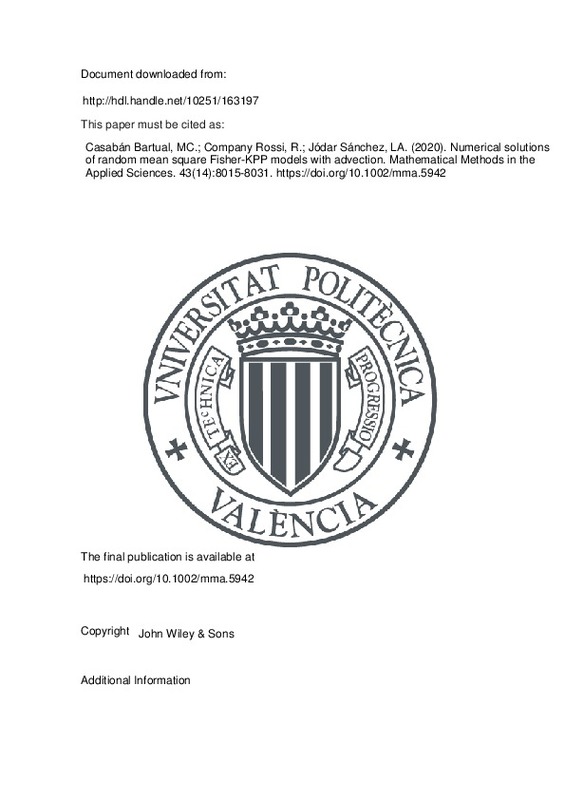FISHER, R. A. (1937). THE WAVE OF ADVANCE OF ADVANTAGEOUS GENES. Annals of Eugenics, 7(4), 355-369. doi:10.1111/j.1469-1809.1937.tb02153.x
Bengfort, M., Malchow, H., & Hilker, F. M. (2016). The Fokker–Planck law of diffusion and pattern formation in heterogeneous environments. Journal of Mathematical Biology, 73(3), 683-704. doi:10.1007/s00285-016-0966-8
Okubo, A., & Levin, S. A. (2001). Diffusion and Ecological Problems: Modern Perspectives. Interdisciplinary Applied Mathematics. doi:10.1007/978-1-4757-4978-6
[+]
FISHER, R. A. (1937). THE WAVE OF ADVANCE OF ADVANTAGEOUS GENES. Annals of Eugenics, 7(4), 355-369. doi:10.1111/j.1469-1809.1937.tb02153.x
Bengfort, M., Malchow, H., & Hilker, F. M. (2016). The Fokker–Planck law of diffusion and pattern formation in heterogeneous environments. Journal of Mathematical Biology, 73(3), 683-704. doi:10.1007/s00285-016-0966-8
Okubo, A., & Levin, S. A. (2001). Diffusion and Ecological Problems: Modern Perspectives. Interdisciplinary Applied Mathematics. doi:10.1007/978-1-4757-4978-6
SKELLAM, J. G. (1951). RANDOM DISPERSAL IN THEORETICAL POPULATIONS. Biometrika, 38(1-2), 196-218. doi:10.1093/biomet/38.1-2.196
Aronson, D. G., & Weinberger, H. F. (1975). Nonlinear diffusion in population genetics, combustion, and nerve pulse propagation. Partial Differential Equations and Related Topics, 5-49. doi:10.1007/bfb0070595
Aronson, D. ., & Weinberger, H. . (1978). Multidimensional nonlinear diffusion arising in population genetics. Advances in Mathematics, 30(1), 33-76. doi:10.1016/0001-8708(78)90130-5
Weinberger, H. F. (2002). On spreading speeds and traveling waves for growth and migration models in a periodic habitat. Journal of Mathematical Biology, 45(6), 511-548. doi:10.1007/s00285-002-0169-3
Weinberger, H. F., Lewis, M. A., & Li, B. (2007). Anomalous spreading speeds of cooperative recursion systems. Journal of Mathematical Biology, 55(2), 207-222. doi:10.1007/s00285-007-0078-6
Liang, X., & Zhao, X.-Q. (2006). Asymptotic speeds of spread and traveling waves for monotone semiflows with applications. Communications on Pure and Applied Mathematics, 60(1), 1-40. doi:10.1002/cpa.20154
E. Fitzgibbon, W., Parrott, M. E., & Webb, G. (1995). Diffusive epidemic models with spatial and age dependent heterogeneity. Discrete & Continuous Dynamical Systems - A, 1(1), 35-57. doi:10.3934/dcds.1995.1.35
Kinezaki, N., Kawasaki, K., & Shigesada, N. (2006). Spatial dynamics of invasion in sinusoidally varying environments. Population Ecology, 48(4), 263-270. doi:10.1007/s10144-006-0263-2
Jin, Y., Hilker, F. M., Steffler, P. M., & Lewis, M. A. (2014). Seasonal Invasion Dynamics in a Spatially Heterogeneous River with Fluctuating Flows. Bulletin of Mathematical Biology, 76(7), 1522-1565. doi:10.1007/s11538-014-9957-3
Faou, E. (2009). Analysis of splitting methods for reaction-diffusion problems using stochastic calculus. Mathematics of Computation, 78(267), 1467-1483. doi:10.1090/s0025-5718-08-02185-6
Doering, C. R., Mueller, C., & Smereka, P. (2003). Interacting particles, the stochastic Fisher–Kolmogorov–Petrovsky–Piscounov equation, and duality. Physica A: Statistical Mechanics and its Applications, 325(1-2), 243-259. doi:10.1016/s0378-4371(03)00203-6
Siekmann, I., Bengfort, M., & Malchow, H. (2017). Coexistence of competitors mediated by nonlinear noise. The European Physical Journal Special Topics, 226(9), 2157-2170. doi:10.1140/epjst/e2017-70038-6
McKean, H. P. (1975). Application of brownian motion to the equation of kolmogorov-petrovskii-piskunov. Communications on Pure and Applied Mathematics, 28(3), 323-331. doi:10.1002/cpa.3160280302
Berestycki, H., & Nadin, G. (2012). Spreading speeds for one-dimensional monostable reaction-diffusion equations. Journal of Mathematical Physics, 53(11), 115619. doi:10.1063/1.4764932
Cortés, J. C., Jódar, L., Villafuerte, L., & Villanueva, R. J. (2007). Computing mean square approximations of random diffusion models with source term. Mathematics and Computers in Simulation, 76(1-3), 44-48. doi:10.1016/j.matcom.2007.01.020
Villafuerte, L., Braumann, C. A., Cortés, J.-C., & Jódar, L. (2010). Random differential operational calculus: Theory and applications. Computers & Mathematics with Applications, 59(1), 115-125. doi:10.1016/j.camwa.2009.08.061
Casabán, M.-C., Cortés, J.-C., & Jódar, L. (2016). Solving linear and quadratic random matrix differential equations: A mean square approach. Applied Mathematical Modelling, 40(21-22), 9362-9377. doi:10.1016/j.apm.2016.06.017
Sarmin, E. N., & Chudov, L. A. (1963). On the stability of the numerical integration of systems of ordinary differential equations arising in the use of the straight line method. USSR Computational Mathematics and Mathematical Physics, 3(6), 1537-1543. doi:10.1016/0041-5553(63)90256-8
Sanz-Serna, J. M., & Verwer, J. G. (1989). Convergence analysis of one-step schemes in the method of lines. Applied Mathematics and Computation, 31, 183-196. doi:10.1016/0096-3003(89)90118-5
Calvo, M. P., de Frutos, J., & Novo, J. (2001). Linearly implicit Runge–Kutta methods for advection–reaction–diffusion equations. Applied Numerical Mathematics, 37(4), 535-549. doi:10.1016/s0168-9274(00)00061-1
Cox, S. M., & Matthews, P. C. (2002). Exponential Time Differencing for Stiff Systems. Journal of Computational Physics, 176(2), 430-455. doi:10.1006/jcph.2002.6995
De la Hoz, F., & Vadillo, F. (2016). Numerical simulations of time-dependent partial differential equations. Journal of Computational and Applied Mathematics, 295, 175-184. doi:10.1016/j.cam.2014.10.006
Company, R., Egorova, V. N., & Jódar, L. (2018). Conditional full stability of positivity-preserving finite difference scheme for diffusion–advection-reaction models. Journal of Computational and Applied Mathematics, 341, 157-168. doi:10.1016/j.cam.2018.02.031
Kaczorek, T. (2002). Positive 1D and 2D Systems. Communications and Control Engineering. doi:10.1007/978-1-4471-0221-2
Pazy, A. (1983). Semigroups of Linear Operators and Applications to Partial Differential Equations. Applied Mathematical Sciences. doi:10.1007/978-1-4612-5561-1
[-]







![[Cerrado]](/themes/UPV/images/candado.png)


